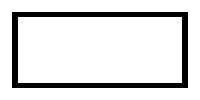imagesetthickness
(PHP 4 >= 4.0.6, PHP 5)
imagesetthickness — 设定画线的宽度
说明
bool imagesetthickness
( resource
$image
, int $thickness
)
imagesetthickness()
把画矩形,多边形,椭圆等等时所用的线宽设为
thickness 个像素。成功时返回 TRUE, 或者在失败时返回 FALSE.
Note: 此函数需要 GD 2.0.1 或更高版本(推荐 2.0.28 及更高版本)。
返回值
成功时返回 TRUE, 或者在失败时返回 FALSE.
范例
Example #1 imagesetthickness() example
<?php
// Create a 200x100 image
$im = imagecreatetruecolor(200, 100);
$white = imagecolorallocate($im, 0xFF, 0xFF, 0xFF);
$black = imagecolorallocate($im, 0x00, 0x00, 0x00);
// Set the background to be white
imagefilledrectangle($im, 0, 0, 299, 99, $white);
// Set the line thickness to 5
imagesetthickness($im, 5);
// Draw the rectangle
imagerectangle($im, 14, 14, 185, 85, $black);
// Output image to the browser
header('Content-Type: image/png');
imagepng($im);
imagedestroy($im);
?>
以上例程的输出类似于:

注释
Note: 此函数需要 GD 2.0.1 或更高版本(推荐 2.0.28 及更高版本)。